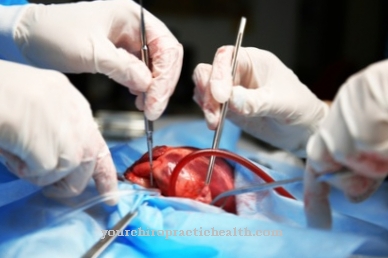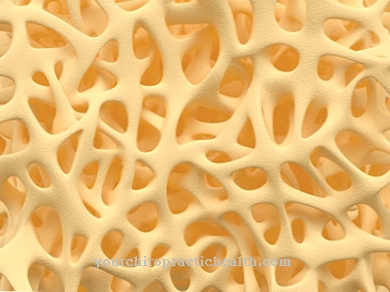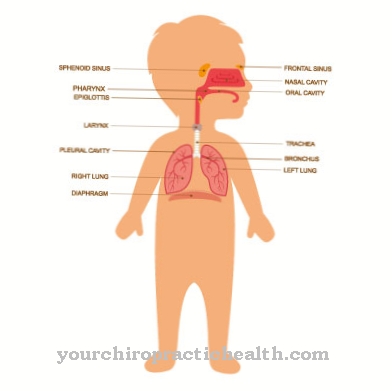Under one Cystocele a bladder prolapse is understood. The urinary bladder bulges towards the anterior vaginal wall.
What is a cystocele?
From one Cystocele is the talk when the woman's bladder bulges into the vagina. The reason for this is a weak pelvic floor, which is usually associated with a sagging or prolapsed vagina. If the urethra also has a share in the bulging, which is not infrequently the case, doctors speak of a urethrocystocele.
Other names for a cystocele are Bladder prolapse, Bladder hernia or Prolapse of the bladder. A cystocele is almost always found in women. It is characterized by being turned into the front wall of the vagina. Sometimes the prolapse extends to the entrance of the vagina (introitus vaginae) or even further.
In most patients, this is a secondary consequence of a prolapse of the uterus or vagina. In men, cystocele is extremely rare. This can occur with an inguinal hernia or a femoral hernia.
causes
The pelvic floor is made up of ligaments, muscles and tissue. These have the function of supporting the urinary bladder and other organs. Over the years, the connection between the pelvic floor muscles and the ligaments that are located above them may weaken. This weakness is usually caused by childbirth or injuries that result in overexertion.
As a result of the weakening, the muscles of the pelvic floor are no longer able to fix the urinary bladder. As a result, it sags in the lower direction, creating a cystocele. The main causes of the development of a cystocele include not only childbirth and pregnancy, but also obesity, strenuous movements of the bowel, chronic coughing and lifting heavy loads.
The number of births also plays a decisive role, because the more children are born by a woman, the greater the risk of developing a cystocele. Another risk factor for a bladder prolapse is a deficiency in the hormone estrogen. This has a strengthening effect on the female pelvic floor muscles.
With age-related decline in the number of hormones, the risk of cystoceles increases. Bladder prolapse often affects women after menopause. A weakening of the pelvic floor muscles is also possible through the surgical removal of the uterus.
Symptoms, ailments & signs
It is not uncommon for a cystocele to be asymptomatic, so that the women affected do not experience any symptoms. Most of the time, these are mild cystoceles. In more severe cases, however, symptoms such as a feeling of pressure in the pelvic region or a feeling of fullness can become noticeable. This is especially the case after long periods of standing.
The feeling of discomfort increases with exertion, lifting loads, bending over or coughing. Furthermore, inflammation of the bladder, frequent urination, pain or urine output during sexual intercourse and urinary incontinence are also conceivable in the context of a cystocele. A large cystocele can also cause urinary retention. Sometimes even bladder tissue comes out of the vaginal opening. The person concerned feels as if she is sitting on an egg.
Diagnosis & course of disease
If a cystocele is suspected, the attending physician will examine the pelvic floor. The doctor checks whether the bladder has advanced into the vagina. As part of the vaginal examination, the doctor lowers the bladder floor with a speculum. In addition, the outer vaginal vault and the front wall of the vagina are bulged.
Diagnosing cystocele is easier with an abdominal press and a filled bladder. The difference between whether the defect is lateral or central plays a role in precise diagnosis. In the case of a distension cystocele, there is a smooth spreading of the vaginal wall. With a displacement cystocele, on the other hand, there are vaginal wrinkles in which only the side furrows are flattened.
A lateral defect can be identified by lifting the furrows with a pair of forceps. The diagnosis can be confirmed by a sonography (ultrasound examination). The course of a cystocele depends on its severity. Mild forms that do not show any symptoms do not require any special treatment. In severe cases, however, medical treatment is necessary.
Complications
In most cases, this condition causes various bladder complaints. Those affected usually feel a feeling of pressure on the bladder, which significantly reduces and restricts the quality of life. A feeling of fullness in the pelvic area can also occur and is particularly noticeable after standing for a long time.
In addition, if the disease is not treated, inflammation of the bladder or urinary tract can occur. A frequent urge to urinate can also occur and make everyday life much more difficult for the person concerned. Pain occurs when defecating or urinating. The pain can also occur during sexual intercourse and possibly have a negative effect on the relationship with the partner. Without treatment, the condition can lead to irreversible damage.
The complaints are usually resolved without complications with the help of a surgical procedure. Exercising the pelvis can prevent this condition. The life expectancy of the patient is also not negatively affected. If the tissue of the bladder is already damaged, the tissue can be transplanted.
When should you go to the doctor?
A time when there is no symptoms is characteristic of the cystocele. Despite the present disease, the affected people often do not notice the changes taking place in the organism due to the initially minor effects. The process usually takes several months. For this reason, it is advisable to take part in regular checkups and preventive examinations. The health status should be compared and documented by a doctor once or twice a year. This enables early detection and thus a timely diagnosis. When the first symptoms appear, the disease is usually already advanced. Disorders when using the toilet, especially when urinating, should therefore be examined by a doctor as soon as possible.
If urinary incontinence occurs, there is cause for concern. If this is not due to a one-off situation, a doctor is required. Pain, swelling, or other abdominal irregularities should be examined and treated. If the physical capacity drops or if there are irregularities in the execution of physical exertion, a doctor should be consulted. If the daily obligations cannot be fulfilled without complaints, the person concerned needs help. Behavioral problems, inner restlessness and withdrawal from social life are seen as warning signals. If pain occurs or sleep disturbances occur, a doctor should be consulted.
Therapy & Treatment
If a cystocele has been diagnosed, you should have regular check-ups with your doctor. In this way, a possible worsening of the bladder prolapse can be recognized. Preventive training can be carried out to prevent the cystocele from getting worse. If treatment of the prolapsed bladder is necessary, a pessary is inserted into the vagina to support the bladder.
This is a small ring made of rubber or plastic. The doctor explains to the patient how to insert and clean the pessary. In some cases, the targeted administration of estrogen can also be useful. The pelvic floor is strengthened by the hormone. Sometimes surgery cannot be avoided.
In the case of a stretch cystocele, an anterior vaginal plasty takes place. In the case of a displacement cystocele, a paravaginal colpopexy is performed. The surgeon fixes the vagina back on the side wall of the pelvis. Sometimes it is also necessary to use special transplant tissue.
prevention
Regular exercises of the pelvic floor muscles are recommended so that a cystocele does not develop in the first place. Among other things, Kegel exercises take place. It also makes sense not to lift too heavy loads.
Aftercare
If the cystocele has to be treated with surgery, follow-up treatment will take place. As a rule, kidney and residual urine sonography is performed on the day of the operation as a check-up. A physical examination will follow to determine possible complications.This can also include a gynecological examination.
In the first time after the operation, it is essential to avoid heavy physical strain. This means that no heavy loads may be lifted. It is also useful to keep the stool soft, which is possible through a specific diet. In this way, you can avoid excessive cramping.
If you are overweight, it is recommended to reduce it depending on your body mass index (BMI). In some cases, vaginal douching and sexual intercourse must be avoided for a certain period of time after the operation. Regular pelvic floor training is an important part of aftercare.
The exercises, which mainly include Kegel exercises, are to be followed consistently. The check-ups with the doctor, which also have to be visited regularly, are essential. If there are any abnormalities during the follow-up treatment that indicate possible complications such as bleeding, bruising, bladder or bowel problems, these must be reported to the attending physician as soon as possible so that he can take appropriate therapeutic measures.
You can do that yourself
If there is a risk of recurrence of cystocele, various self-help measures can be taken to reduce the risk. This primarily includes strengthening the pelvic floor. Strengthening the pelvic floor is particularly recommended after the birth of a child. For this purpose, kegel exercises are performed at regular intervals. If these exercises take place consistently, the weakening of the pelvic floor can in most cases be remedied. Preventive exercises are just as useful, even if there is no cystocele. Corresponding offers can u. a. found in fitness centers, sports clubs or self-help groups.
To avoid another anterior prolapse, it is important not to lift objects that are too heavy. The same goes for proper lifting. For example, lifting shouldn't strain the back and waist, but rather the legs.
It is also important to counteract a blockage of the intestine. To achieve this, a high-fiber diet makes sense. If a chronic cough or bronchitis is present, these conditions should definitely be treated properly in order to prevent a prolapse of the urinary bladder.
Another self-help measure is avoiding excessive weight. The doctor can determine the ideal weight. The doctor also gives useful advice on weight loss, which can then be used in everyday life.
























.jpg)



